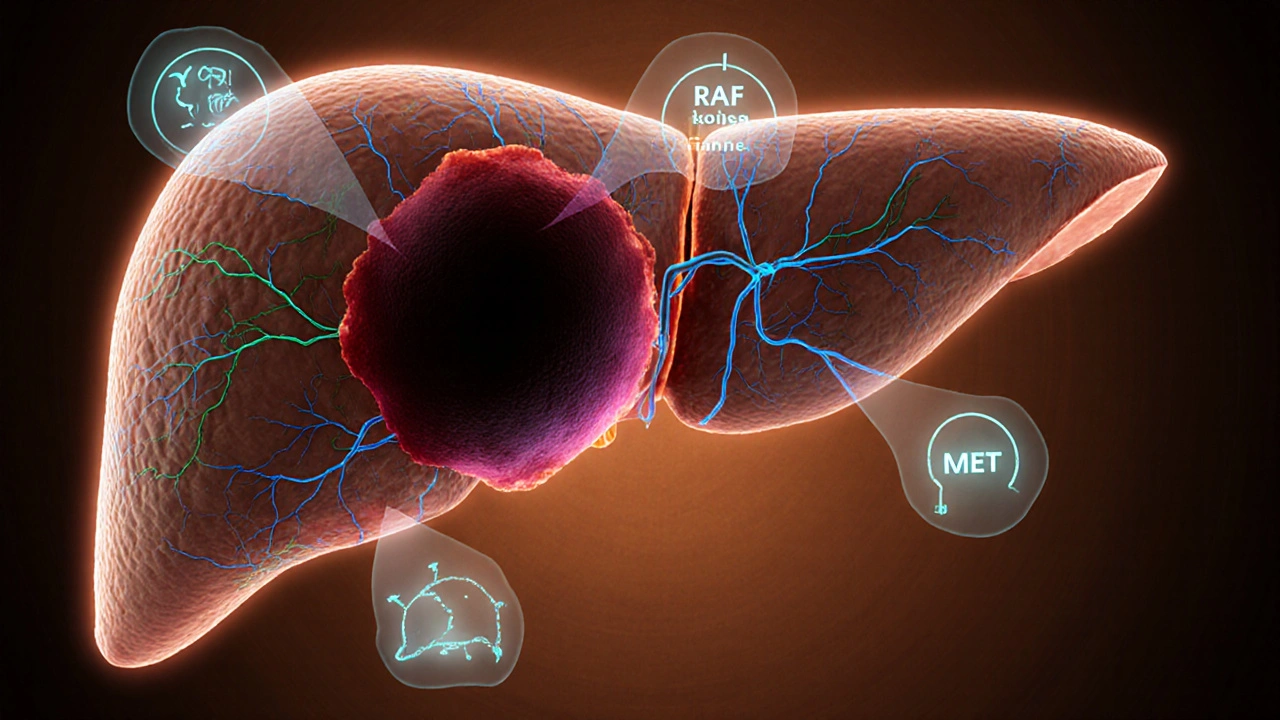
Liver Cancer Treatment Selector
Recommended Treatment Options
FDA-Approved Targeted Therapies for Advanced HCC
Sorafenib
Targets: Raf, VEGFR-1/2/3, PDGFR-β
Median OS: 10.7 months
Side Effects:
Hand-foot skin reaction
Diarrhea
Hypertension
Lenvatinib
Targets: VEGFR-1/2/3, FGFR-1/2/3, PDGFR-α
Median OS: 13.6 months
Side Effects:
Hypertension
Proteinuria
Fatigue
Regorafenib
Targets: VEGFR-1/2/3, TIE2, Raf
Median OS: 13.0 months
Side Effects:
Hand-foot skin reaction
Liver enzyme elevation
Cabozantinib
Targets: MET, VEGFR-2, AXL
Median OS: 10.2 months
Side Effects:
Diarrhea
Fatigue
Hypertension
Ramucirumab
Targets: VEGFR-2 (antibody)
Median OS: 8.5 months (AFP ≥ 400 ng/mL subset)
Side Effects:
Hypertension
Hepatic toxicity
When it comes to liver cancer, the shift from one‑size‑fits‑all chemotherapy to therapies that zero in on the tumor’s specific drivers is reshaping patient outcomes. This article breaks down the newest targeted therapy for liver cancer, explains who benefits most, and outlines what the next wave of options might look like.
Key Takeaways
- Targeted agents such as sorafenib, lenvatinib, regorafenib, cabozantinib and ramucirumab are now standard first‑ or second‑line options for advanced hepatocellular carcinoma (HCC).
- Precision biomarkers - especially alpha‑fetoprotein (AFP) levels and VEGF pathway activity - guide drug selection and improve response rates.
- Combination regimens that add immune checkpoint inhibitors (e.g., atezolizumab + bevacizumab) are extending overall survival beyond two years in many patients.
- Ongoing trials (e.g., IMBRAVE050, NIVO-TRIAL) are testing novel targets like mTOR, FGFR4 and KRAS, promising even tighter personalization.
- Managing on‑target toxicities (hand‑foot skin reaction, hypertension, liver‑function changes) is crucial for keeping patients on therapy.
Targeted therapy for liver cancer is a treatment approach that uses drugs designed to block specific molecular pathways that fuel tumor growth and spread. Unlike traditional chemotherapy, which attacks all rapidly dividing cells, these agents aim at the cancer’s “Achilles’ heel,” often resulting in better tolerability and longer survival.
Understanding Liver Cancer
Hepatocellular carcinoma (HCC) is the most common primary liver cancer, accounting for roughly 75% of cases worldwide. Risk factors include chronic hepatitis B or C infection, cirrhosis from alcohol or non‑alcoholic fatty liver disease, and certain genetic disorders. Early‑stage HCC can be cured with surgery or ablation, but the majority of patients present with intermediate or advanced disease, where systemic therapy becomes essential.
How Targeted Therapies Work
Most approved agents interfere with the vascular endothelial growth factor (VEGF) pathway, a key driver of the liver’s rich blood supply to tumors. By blocking VEGF receptors or downstream kinases, these drugs starve the tumor of nutrients. Other agents act on the MAPK/ERK cascade, the platelet‑derived growth factor (PDGF) axis, or the MET pathway, each contributing to cell proliferation, angiogenesis, or metastasis.

FDA‑Approved Targeted Agents
The United States Food and Drug Administration (FDA) has cleared five single‑agent tyrosine‑kinase inhibitors (TKIs) for advanced HCC, plus one monoclonal antibody targeting VEGF‑2. Below is a concise comparison.
| Drug | Primary Target | Approval Year | Median Overall Survival (months) | Key Side Effects |
|---|---|---|---|---|
| Sorafenib | Raf, VEGFR‑1/2/3, PDGFR‑β | 2007 | 10.7 | Hand‑foot skin reaction, diarrhea, hypertension |
| Lenvatinib | VEGFR‑1/2/3, FGFR‑1/2/3, PDGFR‑α | 2018 | 13.6 (non‑inferior to sorafenib) | Hypertension, proteinuria, fatigue |
| Regorafenib | VEGFR‑1/2/3, TIE2, Raf | 2017 | 13.0 (second‑line after sorafenib) | Hand‑foot skin reaction, liver enzyme elevation |
| Cabozantinib | MET, VEGFR‑2, AXL | 2019 | 10.2 (second‑line) | Diarrhea, fatigue, hypertension |
| Ramucirumab | VEGFR‑2 (antibody) | 2019 | 8.5 (AFP ≥ 400ng/mL subset) | Hypertension, hepatic toxicity |
Choosing the Right Therapy
Selection hinges on two practical factors: where the patient sits in the treatment line and what biomarkers the tumor displays. For instance, ramucirumab is approved only for patients with AFP levels ≥400ng/mL after sorafenib failure. Meanwhile, lenvatinib is a first‑line alternative to sorafenib for patients who can tolerate higher blood‑pressure spikes.
Performance status (ECOG 0‑1) and underlying liver function (Child‑Pugh A) remain gatekeepers for any systemic drug. Patients with decompensated cirrhosis (Child‑Pugh B or C) are usually steered toward clinical trials or palliative care because targeted agents can exacerbate liver injury.
Emerging Combinations & Clinical Trials
Monotherapy has given way to synergistic combos that enlist the immune system. The IMBRAVE150 trial showed that the anti‑PD‑L1 antibody atezolizumab plus the anti‑VEGF antibody bevacizumab achieved a median overall survival of 19.2months-well beyond the historic 13‑month ceiling of TKIs alone.
Current late‑phase studies are layering TKIs on top of the atezolizumab-bevacizumab backbone, testing whether further blockade of MET (cabozantinib) or FGFR4 (FGF401) pushes survival past the 24‑month mark. The NIVO‑TRIAL (Nivolumab+cabozantinib) reported a 30% objective response rate in a heavily pre‑treated cohort, hinting at a future where the line between “targeted” and “immunotherapy” blurs.

Managing Side Effects
Even though targeted agents are more selective, they still cause on‑target toxicities. Hand‑foot skin reaction, a hallmark of sorafenib and regorafenib, can be mitigated with moisturizers, dose interruptions, and corticosteroid creams. Hypertension, frequent with VEGFR inhibitors, is best controlled by early initiation of ACE inhibitors or calcium‑channel blockers.
Liver‑function monitoring is non‑negotiable. A rise in bilirubin or transaminases >3×baseline should prompt a dose reduction or temporary hold, especially for regorafenib and cabozantinib, which have higher hepatic clearance.
Future Outlook
The next frontier is biomarker‑driven precision medicine. Next‑generation sequencing (NGS) panels now routinely detect mutations in TP53, CTNNB1, and TERT promoter-all of which influence response to specific TKIs. Artificial‑intelligence models are being trained on real‑world data to predict which patients will benefit most from a given combo, potentially slashing the trial‑and‑error period.
By 2030, it’s plausible that every HCC patient will have a personalized treatment algorithm that integrates genomic data, circulating tumor DNA, and immune‑profile scores, selecting from a toolbox that includes TKIs, checkpoint inhibitors, anti‑FGFR agents, and even on‑colony CAR‑T therapies targeting GPC3.
Frequently Asked Questions
What is the difference between sorafenib and lenvatinib?
Both inhibit VEGF signaling, but lenvatinib also blocks FGFR‑1/2/3, giving it a broader anti‑angiogenic footprint. Clinical trials showed similar overall survival, yet lenvatinib often produces higher response rates but a greater incidence of hypertension.
When should a patient switch from first‑line to second‑line therapy?
Switching is recommended when radiographic progression occurs, when side effects become unmanageable despite dose adjustments, or when liver function deteriorates to Child‑Pugh B. At that point, agents like regorafenib (after sorafenib) or cabozantinib become viable options.
Is immunotherapy an option for all HCC patients?
Atezolizumab + bevacizumab is approved for patients with preserved liver function (Child‑Pugh A) and ECOG 0‑1. Those with advanced cirrhosis or autoimmune disorders may not tolerate checkpoint blockers and should consider clinical trials instead.
How important is AFP testing in treatment decisions?
AFP guides therapy chiefly for ramucirumab, which is approved only when AFP ≥400ng/mL. Elevated AFP also signals aggressive disease, prompting earlier imaging and possibly more aggressive combination regimens.
What lifestyle changes support targeted therapy effectiveness?
Maintaining a balanced diet low in alcohol, managing weight, and adhering to antiviral therapy for hepatitis B or C reduce liver stress and can improve drug tolerance. Regular exercise also helps control hypertension, a common side effect of VEGF inhibitors.
17 Comments
Ian McKay
October 5, 2025 At 17:36Targeted therapy for hepatocellular carcinoma has indeed broadened treatment options. However, the survival benefit remains modest compared with historical expectations. Careful patient selection is essential to justify its use.
Deborah Messick
October 9, 2025 At 04:56While the article extols the virtues of molecularly targeted agents, one must acknowledge that the data are frequently derived from heterogeneous cohorts, and the incremental survival gain is marginal at best. Moreover, the ethical implications of exposing patients to costly agents with limited quality‑of‑life improvements deserve rigorous scrutiny. Consequently, the celebration of these therapies appears premature.
Jolanda Julyan
October 9, 2025 At 06:20The development of drugs that block specific pathways has changed how we think about liver cancer.
In the early days doctors only had chemotherapy, which hurt many healthy cells.
Now we have pills that aim at the tumor’s own signals, and patients can stay feeling better longer.
Sorafenib was the first such drug and it showed that even a few months of extra life can matter.
Lenvatinib entered the scene later and proved it could match sorafenib while giving a higher response rate.
Regorafenib gave hope to those whose disease progressed after the first drug.
Cabozantinib added another mechanism by hitting MET and AXL, which are important for spread.
Ramucirumab is special because it only works when AFP levels are high, showing the power of biomarkers.
The combination of atezolizumab with bevacizumab now pushes survival beyond two years for many patients.
Ongoing trials are testing whether adding new agents to that combo will push the envelope even further.
Importantly, doctors must watch for side effects like hand‑foot skin reaction and high blood pressure, which can limit therapy.
Regular monitoring of liver function tests is a must, especially when using drugs cleared by the liver.
Patients who are in good performance status and have Child‑Pugh A livers are the ones who benefit most.
Those with poorer liver function should consider clinical trials or palliative care instead of aggressive drugs.
In summary, the era of one‑size‑fits‑all chemotherapy is ending, and personalized targeted therapy is now the cornerstone of modern HCC treatment.
Kevin Huston
October 12, 2025 At 23:13Let’s cut the crap-if you’re not willing to fund these pricey biotech marvels, you’re basically saying “I don’t care about my liver cancer.” These fancy TKIs are the golden tickets for the pharma elite, and anyone who doubts their efficacy must be living under a rock. The data? Sure, they show median survivals in the low‑teens, which is just a drop in the ocean for a disease that still kills the majority. Still, we soldier on, because “innovation” tastes better than “nothing at all.”
Amanda Hamlet
October 13, 2025 At 00:36Yo Kevin, u think u know it all but u r missin the point-these drugs r not just some fancy pill to brag about. Most patients cant even afford the co-pay, and u keep pushin the agenda like it's a pride parade. Stop trippin and think about real folks w/ limited wallets. The side effects r real, not just hype.
Nolan Jones
October 16, 2025 At 10:33Targeted meds can extend life if liver function is still good.
Jada Singleton
October 16, 2025 At 11:56Your statement oversimplifies a complex therapeutic landscape; while brevity is admirable, the nuance regarding patient heterogeneity and drug tolerability cannot be ignored.
Emily Rossiter
October 19, 2025 At 21:53Great overview! It’s encouraging to see how each therapy fits a specific patient profile, and your emphasis on monitoring side effects really helps clinicians keep patients safe.
Renee van Baar
October 19, 2025 At 23:16Indeed, the key takeaway is that personalized treatment planning, based on performance status and biomarker data, empowers both doctors and patients to make informed choices that align with individual goals.
Mithun Paul
October 23, 2025 At 09:13The exposition, though comprehensive, neglects to address the economic burden imposed by these agents and the concomitant disparity in global access, thereby presenting an incomplete perspective on their clinical utility.
Sandy Martin
October 23, 2025 At 10:36i totally get how overwhelming all these options can feel-just remember you’re not alone and there are folks out ther ready to help guide you through the choices.
Steve Smilie
October 26, 2025 At 20:33One must appreciate the sublime elegance of targeting angiogenic cascades; it is a veritable ballet of molecular choreography that elevates oncologic therapy to an art form beyond mere pharmacology.
Josie McManus
October 26, 2025 At 21:56Listen, I get it-this stuff can be scary, but trust the data and push for the best regimen you qualify for; don't let fear hold you back from the most effective treatment available.
Heather Kennedy
October 30, 2025 At 07:53From a pharmacodynamics standpoint, the inhibition of VEGFR-2 by ramucirumab exemplifies a ligand‑directed antagonism, thereby attenuating downstream angiogenic signaling pathways that are pivotal in HCC pathogenesis.
Janice Rodrigiez
October 30, 2025 At 09:16Use TKIs early if you’re fit and keep an eye on blood pressure and liver labs
Roger Cardoso
November 2, 2025 At 19:13While the mainstream narrative glorifies these targeted agents, the underlying agenda is clear: pharmaceutical conglomerates are engineering dependency, steering patients toward perpetual treatment cycles that line their pockets, all under the guise of scientific progress.
barry conpoes
November 2, 2025 At 20:36America leads the world in developing these life‑saving therapies, and we should proudly support our domestic biotech innovation rather than bow to foreign skepticism.

Post A Comment